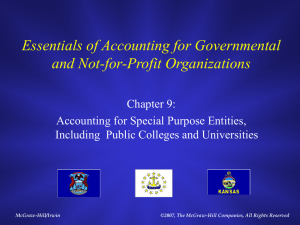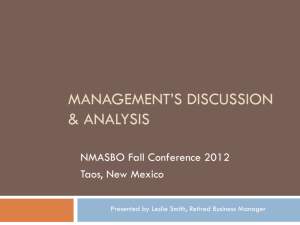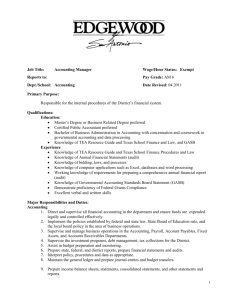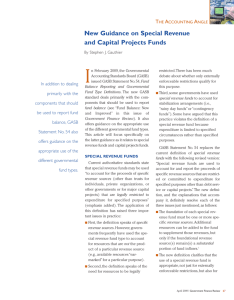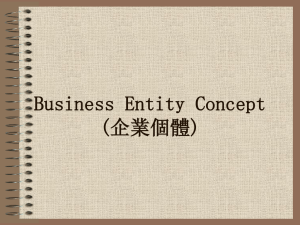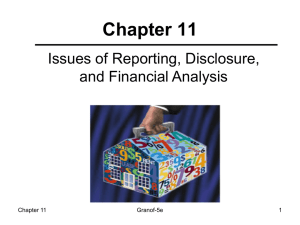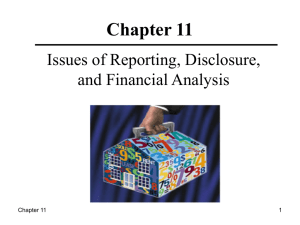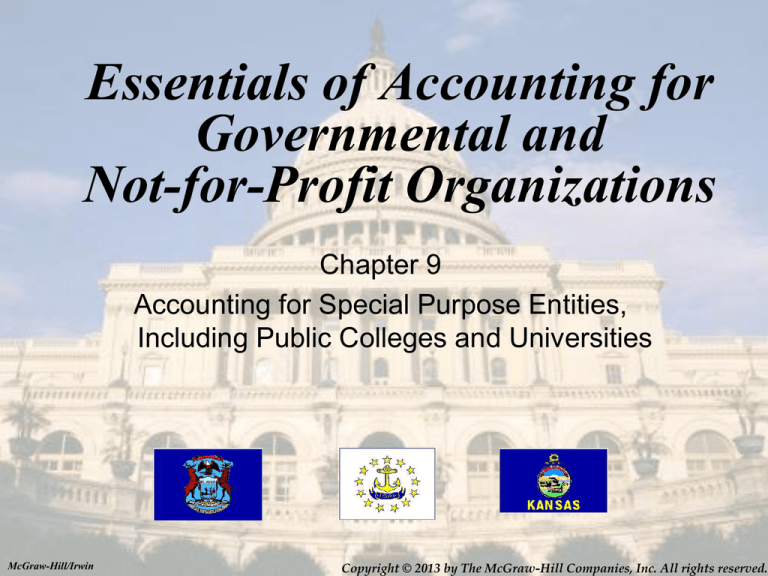
Essentials of Accounting for
Governmental and
Not-for-Profit Organizations
Chapter 9
Accounting for Special Purpose Entities,
Including Public Colleges and Universities
McGraw-Hill/Irwin
Copyright © 2013 by The McGraw-Hill Companies, Inc. All rights reserved.
Special Purpose Entities
General Purpose
Governments include:
States, counties, cities,
towns, and villages.
Special Purpose
Entities include: Fire
protection districts, park
districts, and public
authorities.
A Special Purpose Entity
may be a component unit
of a General Purpose
government.
9-2
Special Purpose Entity Reporting
If the entity is engaged in governmental and business
type activities
Use general GASB 34 reporting model (chapters 3-8) and report
both fund basis and government-wide financial statements
If the entity is engaged in multiple governmental
activities
Use general GASB 34 model, just omit enterprise funds
statements which are not applicable. Again, report both fund
basis and government-wide financial statements
9-3
Special Purpose Entity Reporting
If the entity is engaged in single governmental activity
If the entity is engaged only in business-type activities
The entity can prepare governmental fund, government-wide
statements, and reconciliation effects all on one statement
The entity can prepare enterprise fund financial statements (no
need for government-wide)
If the entity is engaged only in fiduciary type activities
The entity can prepare fiduciary fund financial statements (no
need for government-wide)
9-4
Example – Combined Balance Sheet, Statement of Net Assets(position)
Capital
Total Governmental
General Fund Projects Fund
Funds
Assets
Cash
Investments
Taxes Receivable - Gross
Interest Receivable
Prepaid Items
Capital Assets
Accumulated Depreciation
Total Assets
Liabilities and Fund Balances
Liabilities
Accounts Payable
Accrued Liabilities
Deferred Property Taxes
Contracts payable - Retained %
Long-term Notes Payable
Total Liabilities
Fund Balances
Nonspendable
Assigned
Capital projects
Unassigned
Total Fund
Balances
$
$
1,500,000 $
500,000
200,000
5,000
12,000
2,217,000 $
840,000
250,000
65,000
4,800,500 $
4,800,500 $
62,500
700,000
1,155,000
762,500
12,000
58,000
992,000
4,038,000
1,062,000
4,038,000
6,300,500
500,000
200,000
5,000
12,000
7,017,500
902,500
250,000
65,000
700,000
1,917,500
Adjustments to
Government-wide
Statement of Net
Assets(position)
$
$
35,000,000
(7,500,000)
27,500,000
$
6,300,500
500,000
200,000
5,000
12,000
35,000,000
(7,500,000)
34,517,500
902,500
250,000
700,000
15,000,000
16,852,500
(65,000)
15,000,000
14,935,000
12,000
4,096,000
992,000
5,100,000
Net Assets(position)
Net Investment in capital assets
Unrestricted
$
11,800,000
5,865,000
17,665,000
Adjustments to convert to accrual
9-5
PUBLIC Colleges and Universities
Public Colleges and Universities are owned by a
government.
Public College financial reporting is covered by GASB.
Private Colleges are not owned by a government
and their reporting falls under FASB guidance -covered in chapter 11.
Although there are more private than public colleges in the
US, roughly 3/4 of the students attend public institutions.
9-6
Public Colleges and Universities –
GASB 35
GASB 35 requires statements similar to those of special
purpose governments under GASB 34.
The effect is to require colleges to use the accrual basis
and record long-term assets, including infrastructure,
along with depreciation.
9-7
Public College Financial Reports
Although public colleges may have
governmental type activities, business type
activities, or both
Most public colleges, will report as governmental
units with “business activities only”.
Therefore they will prepare enterprise fund
statements
Exception: some community colleges that have
power to levy property taxes, and may prepare both
fund level and government-wide statements
9-8
Public College Statement of Net
Assets(position)
Assets and Liabilities
Are classified as current and noncurrent.
Net Assets(position) are Classified as
1) Net Investment in capital assets
2) Restricted
-- Nonexpendable and Expendable
3) Unrestricted
9-9
Unrestricted Net Asset Deficits
Note: Deficits in unrestricted assets are
common because:
Colleges are not accustomed to setting aside funds for
depreciation.
States seldom fund compensated absences in advance.
9-10
Public College Statement of Revenues,
Expenses and Changes in Net Assets(position)
Format:
Operating Revenues include:
Student Tuition net of scholarship allowances
Federal and State Grants
Auxiliary
Less:
Operating Expenses
including depreciation
Plus or minus:
Nonoperating Revenues and Expenses
Includes state appropriations, gifts, investment
income, interest on capital debt
Plus or minus:
Capital appropriations, gift, endowment additions
Equals:
Plus:
Equals:
Increase in net assets(position)
Beginning net assets(position)
Ending net assets(position)
9-11
Public College Statement of Cash Flows
GASB Format
Cash flows from Operating activities must be presented
using the direct method
Four Parts (described on next slide)
Reconciliation of Operating income to cash flows from
operations
May also have noncash financing and investing section
9-12
Public College Statement of Cash Flows
GASB Format
Classification of Cash Flows – GASB Format
Operating items: Excludes interest and dividend revenues and
expenses
Noncapital Financing: Includes state appropriations and gifts
including endowments
Capital Financing: Purchase of long-term assets and related
gifts, appropriations and debt repayment including interest
Investing: Includes interest revenues, endowment and other
investments kept separate
9-13

